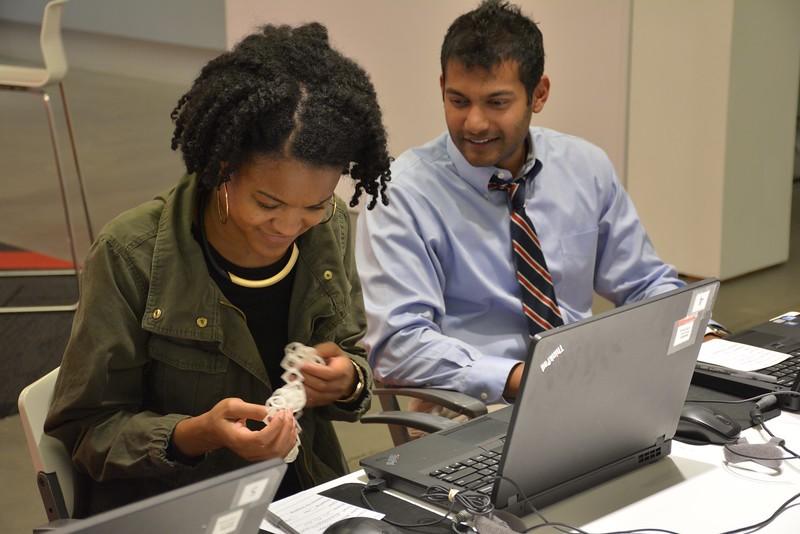Section Branding
Header Content
Making Designers Out Of Everyone With 3-D Printing
Primary Content
3-D printing has been used for years to solve all kinds of problems. Ford Motor Company has been using the technology since the 1980s for prototyping, and, recently, scientists have even used it to print custom skin grafts for burn victims.
One Atlanta art museum is working to make sure 3-D printing and the problem solving it enables stays in the hands of regular people.
The screech of a 3-D printer filled the lobby of the Museum of Design Atlanta as Neil Miller finished setting up for the class he was teaching on a recent weeknight: 3-D Printing for Adults.
Seven laptops sat around a white table on which sat a number of small, colorful, plastic cubes and an intricate bracelet-necklace thing.
“The bracelet-necklace thing is, in fact, one of mine,” Miller said. “And it’s exactly the wrong size, but, you know, it’s a good prototype and a really nice size for people to fidget with.”
It’s also a good example of what someone can do with 3-D modeling and printing and served as a bit of inspiration for the night's class.
The museum has been holding 3-D printing classes since February 2014. In just a few hours, students learn the basics of 3-D modeling and printing. Then, they design something that the museum prints for them using its 3-D printers.
The whole idea is to take away the mystery behind the technology.
“I hope people take away that it’s not magic and that it's something that anybody can do,” Miller said. “If you’ve got a computer, and you’ve got an hour and a half for us to teach you, we can teach you how to 3-D model.”
And, if you can get your hands on a 3-D printer, to turn that model into a 3-D object. Essentially, the class can make you a maker.
“[Those] are people who like to make things,” said Lew Lefton. He's a mathematics professor at Georgia Tech and the man behind Decatur Makers, a kind of maker co-op.
Makers are carpenters, programmers, machinists: anyone interested in making things. Lefton said the maker movement is all about collaboration and sharing ideas, and that 3-D modeling and printing have opened up the movement to more people.
Used to be, if you had an idea for something, you had to make that thing yourself or find someone to do it for you.
“Now you can actually prototype and manufacture production items on 3-D printing for a fraction of the cost in your dining room,” Lefton said. “So, it opens up a great deal of creativity.”
Back in class, the students worked to open up their creativity and access their inner makers. They wore looks of extreme concentration as they studied their screens, and Miller stepped in to help as they had questions.
Most of the designs were modest (it’s a short class, after all) but who knows what the students could have designed if they'd had more time.
That’s something that’s recently been on the mind of MODA’s Executive Director, Laura Flusche.
“Can a 3-D printer be about more than making a plastic trinket?” Flusche asked. “We also got very intrigued and realized the power of this tool to change the way we design.”
MODA’s current exhibit, called “Designers, Makers, Users: 3-D Printing the Future,” examines that question. The exhibit looks at the future of 3-D printing and at how people have used it outside of the design studio or lab.
Flusche, who curated the exhibit, said 3-D printing has democratized design just like it's opened up maker culture, and to her, that matters.
“It’s important to me because I think design is one of the most powerful problem solving processes we have in the 21st century,” she said.
When everyone’s a designer, everyone’s a problem solver, and the more minds working to solve the world’s problems, the better.
After about two hours, class was complete. Most students thanked Miller for his instruction and headed out into the night.
One student, however, stuck around to ask how he could learn more about 3-D printing and design. Who knows what problems he might solve.





